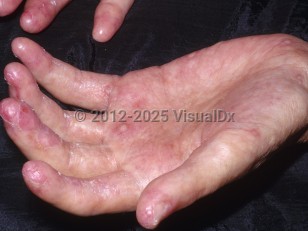Chronic graft-versus-host disease - Oral Mucosal Lesion
See also in: Overview,Nail and Distal DigitAlerts and Notices
Important News & Links
Synopsis

Graft-versus-host disease (GVHD) refers to multiorgan dysfunction resulting from attack of an immunologically deficient host by foreign immunocompetent lymphocytes or bone marrow tissue (the graft). Most GVHD occurs in individuals who have undergone allogeneic bone marrow transplants, but it may occur in solid organ transplant and blood transfusion recipients.
The incidence of chronic GVHD is estimated to be 60%-70% in recipients of allogeneic stem cell transplants with mismatched and unrelated donors, and about 30% in recipients of fully histocompatible sibling donor transplants. Almost all chronic GVHD patients will have skin involvement, and the oral mucosa is involved in 90% of patients with chronic GVHD.
Acute oral GVHD usually manifests 15-20 days after transplantation when engraftment occurs. Patients generally complain of pain, sensitivity, soreness, dryness in the mouth, and sometimes tightness of the oral musculature. The lips, tongue, gums, and buccal mucosae can all be involved. There are often accompanying dental caries and gingivitis / periodontitis, skin rash, irritated eyes, diarrhea, and elevated liver function tests.
More chronically, changes that resemble oral lichen planus may occur. If sclerotic GVHD is present, perioral sclerosis results in reduction of motion of lips and loss of the mandibular and maxillary vestibules.
The incidence of chronic GVHD is estimated to be 60%-70% in recipients of allogeneic stem cell transplants with mismatched and unrelated donors, and about 30% in recipients of fully histocompatible sibling donor transplants. Almost all chronic GVHD patients will have skin involvement, and the oral mucosa is involved in 90% of patients with chronic GVHD.
Acute oral GVHD usually manifests 15-20 days after transplantation when engraftment occurs. Patients generally complain of pain, sensitivity, soreness, dryness in the mouth, and sometimes tightness of the oral musculature. The lips, tongue, gums, and buccal mucosae can all be involved. There are often accompanying dental caries and gingivitis / periodontitis, skin rash, irritated eyes, diarrhea, and elevated liver function tests.
More chronically, changes that resemble oral lichen planus may occur. If sclerotic GVHD is present, perioral sclerosis results in reduction of motion of lips and loss of the mandibular and maxillary vestibules.
Codes
ICD10CM:
D89.811 – Chronic graft-versus-host disease
SNOMEDCT:
402356004 – Chronic graft-versus-host disease
D89.811 – Chronic graft-versus-host disease
SNOMEDCT:
402356004 – Chronic graft-versus-host disease
Look For
Subscription Required
Diagnostic Pearls
Subscription Required
Differential Diagnosis & Pitfalls

To perform a comparison, select diagnoses from the classic differential
Subscription Required
Best Tests
Subscription Required
Management Pearls
Subscription Required
Therapy
Subscription Required
References
Subscription Required
Last Reviewed:02/25/2025
Last Updated:02/26/2025
Last Updated:02/26/2025
Chronic graft-versus-host disease - Oral Mucosal Lesion
See also in: Overview,Nail and Distal Digit
